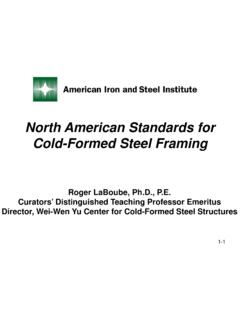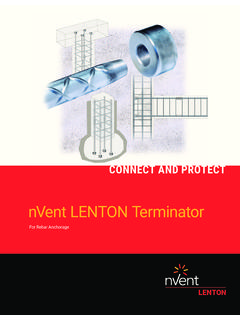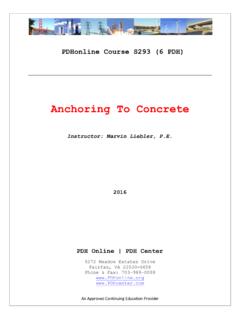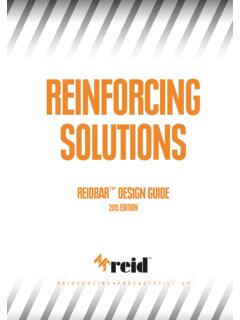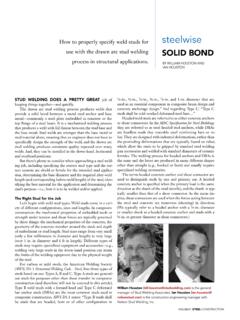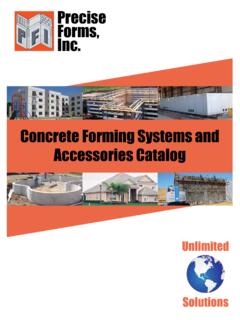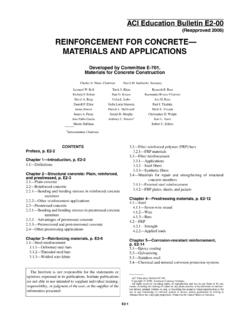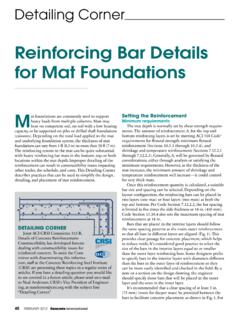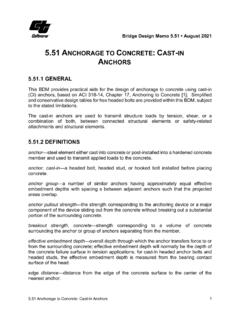Transcription of ACI 318-19: What’s New for 2019
1 James K. Wight, PastACIP resident, Former Chair of Comm. Richart, Jr. CollegiateProfessor of Civil & Env. EngineeringUniversity of MichiganACI 318-19: What s New for 2019 ACI 318-19: What s New for 2019 New Shear Strength Equations;including size-effect factor Higher rebar Grades UpdatedDevelopment Lengths New Effective Stiffnessfor Deflection Calculations Seismic Design Details Shear Walls Some Updates to Strut & Tie MethodChanges to the Concrete Design StandardACI 318-19 Shear ModificationsShear equation changes for one-way and two-way shear Size Effect Low Flexural Reinforcement Ratio Axial load (prestress) Results gathered and vetted by ACI Comm. 445 Why one-way shear equations changed in 318-195 Figure: Strength Ratio (Vtest/Vn)d = 10 in. s, size effect factor,minvvAA Why one-way shear equations changed in min. slab w,minvvAA weffectFigure: Strength Ratio (Vtest/Vn)Why one-way shear equations changed in 318-197d = 10 in. s, size effect factor,minvvAA>Figure: Strength Ratio (Vtest/Vn)One-way shear provision: Modified goals Include nonprestressed and prestressed Include size effect and axial loading Include effect of ( w) Continue to use 2 f c Reduce multiple empirical equations Easy to useACI 318-19 New one-way shear equations Table -Vcfor nonprestressed membersCriteriaVcAv Av,minEither of:2 + 6 (a)8 1 3 + 6 (b)Av < Av,min8 1 3 + 6 (c) load, Nu, is positive for compression and negative for not be taken less than / sqrt(f c)Longitudinal Reinforcement Ratio (As/bd)ACI 318-19 Shear Equation8 1 3 Effect of wSize Effect: Value for s?
2 SDepth in = +Beam discussion Where Av,mininstalled and Nu 0, Vc (2 f c)bwd, ACI 318-14 ~ ACI 318-19 Provisions encourage use of Av, -Minimum shear reinforcement ACI 318-14 Av,minrequired if Vu> Vc ACI 318-19 Av,minrequired if Vu> f cbwdExample: Foundation Shear Check = 12 ft h= 30 in. d~ in. f c= 4000 psi 13-No. 8 bars b= 12 ft Av= 0 As= Analysis Vu= 231 kip3 ft 0 : Foundation Shear Check ACI 318-14'2( )(2)(1) 4000(144 .)( .)348 kip231 kipOKccccVf bdVpsiininV === > Example: Foundation Shear Check ACI 318-19 Av Av,min Per ACI 318-19 ( ), neglect size effect for: One-way shallow foundations Two-way isolated footings Two-way combined and mat foundations1'38( )cwcVf bd =Example: Foundation Shear Check ACI 318-19()1'32138( ) (144 in.)( in.)( )(8)(1) (144 .)( .)196 kip 231 kipNGcwcwccVf bdVpsiininV =====< Example: Foundation Shear Check ACI 318-19 Add 6 in. thickness()1'32138( ) (144 in.)
3 ( in.)( )(8)(1) psi (144 in.)( in.)226 kip > 191 kipOKcwcwccVf bdVV ===== Why two-way shear provisions changed in 318-19 First Equation developed in 1963 for slabs with t < 5 in. and > 1% Two issues similar to one-way shear Size effect Low vcLeast of (a), (b), and (c):(a)(b)(c)'4cf '42cf + '2scodfb + boVc= vc(bod)Two-way shear: size effect Table vcfor two-way members without shear reinforcement vcLeast of (a), (b), and (c):(a)(b)(c)'4csf '42csf + '2sscodfb + 21110sd = +Two-way shear: Effect of low Only vert. load, cracking ~2 ; punching 4 Aggregate interlock contributes to shear strength Low local bar yielding, crack width increase, allows sliding along shear crack Punching loads < 4 Source: Performance and design of punching shear reinforcing system, Ruiz et al, fib 2010 New two-way slab reinforcement limits Need As,min If on the critical section Then,min5uv slab ossyvb bAf '2uvscvf> edgeTable hbslabbslabDefinition of bslabSlab EdgeChanges to the Concrete Design StandardACI 318-19 Development LengthDevelopment Length Straight Deformed Bars and Deformed Wires in Tension Simple modification to 318-14 Accounts for Grade 80 and 100 Standard Hooks and Headed Deformed Bars Substantial changes from 318-14 Straight Development Length of Deformed Bars in Tensionftest= reinforcement stress at the time of failurefcalc= calculated stress.
4 ACI 318-14 UnconfinedStraight Development Length of Deformed Bars in Tension Modification in simplified provisions of Table g : new modification factor based on grade of reinforcement: Grade 80, Grade 100, Development Length of Deformed Bars in Tension Modification in general development length equation (a) for fy 80,000 psi, if longitudinal bar spacing < 6 in. =340 + Modification factors : Lightweight t: Casting position e: Epoxy s: Size g:Reinforcement grade40trtrAKsn= Development Length Deformed Bars and Deformed Wires in Tension Standard Hooks in Tension Headed Deformed Bars in Tension Development Length of Std. Hooks in Tension Failure Modes Mostly, front and side failures Dominant front failure (pullout and blowout) Blowouts were more sudden in natureFront Pullout Front Blowout Side splitting Tail kickoutSide blowout Development Length of Standard Hooks in Tensionfsu= stress at anchorage failure for the hooked bar fs,ACI= stress predicted by the ACI development length equationConfined Test ResultsUnconfined Test ResultsDevelopment Length of Standard Hooks in Development length of standard hooks in tension is the greater of (a) through (c):(a)(b) 8db(c)6 in-Modification factors : Confining reinforcement (redefined) : Location (new) : Concrete strength (new) 55.
5 ACI 318-14 = 50 Development Length of Standard Hooks in TensionModification factorConditionValue of factor318-14 Confining reinforcement, rFor 90-degree hooks of No. 11 and smallerbars(1)enclosed along dhwithin ties or stirrups perpendicular to dhat s 3db, or(2)enclosed along the bar extensionbeyond hook including the bend within tiesor stirrups perpendicular to extat s reinforcement, rFor and smaller bars with Ath s : Modification factors for development of hooked bars in tensionDevelopment Length of Standard Hooks in Tension (1) Confining reinforcement placed parallel to the bar (Typical in beam-column joint) Two or more ties or stirrups parallel to dhenclosing the hooks Evenly distributed with a center-to-center spacing 8db within 15dbof the centerlineof the straight portion of the hooked barsFig. Length of Standard Hooks in Tension (2) Confining reinforcement placed perpendicular to the bar Two or more ties or stirrups perpendicular to dhenclosing the hooks Evenly distributed with a center-to-center spacing 8dbFig.
6 Length of Std. Hooks in TensionModification factorConditionValue of factor318-14 Cover cFor No. 11 bar and smaller hooks with sidecover (normal to plane of hook) 2-1/2 for 90-degree hook with cover on barextension beyond hook 2 , oFor and smaller diameter hooked bars(1)Terminating inside column core w/ side cover normal to plane of hook in., or(2)with side cover normal to plane of hook : Modification factors for development of hooked bars in tensionDevelopment Length of Std. Hooks in TensionModification factorConditionValue of factorConcrete strength, cFor f c< 6000 psif c/15,000 + f c 6000 to the Concrete Design StandardACI 318-19 Deflection EquationsConcerns about deflection calculations Service level deflections based on Branson s equation underpredicteddeflections for below Reports of excessive slab deflections (Kopczynski, Stivaros) High-strength reinforcement may result in lower reinforcement ratios = + Ieshould be the average of flexibilities Branson BischoffBranson combines stiffnesses.
7 Bischoff combines of Branson s and Bischoff s Ie = 3 +1 3 1 = 21 +1 21 1 = 3 +1 3 = 3 +1 3 1 = 21 +1 21 1 Lightly reinforcedMidspan deflectionMidspanmomentExperimentalBrans on s s Eq. Table ~ Inverse of Bischoff Eqn. 2/3 factor added to account for: restraint that reduces effective cracking moment reduced concrete tensile strength during construction Prestressedconcrete maintains use of Branson s Eq. and Moment of Inertia > 2 3 , = 1 2 3 21 2 3 , = > 2 3 , = 1 2 3 21 2 3 , = Changes to the Concrete Design StandardACI 318-19 Special Structural Longitudinal reinforcement ratio at ends of wallshw/ w Failures in Chile and New Zealand 1 or 2 large cracks Minor secondary cracks Longitudinal reinforcement ratio at ends of wallsNew edge reinforcement ratio Well distributed cracks Flexure yielding over longer length'6cyff = Longitudinal reinforcement ratio at ends of (f) Special Boundary ElementsLongitudinal bars supported by a seismic hook or corner of a Changes to the Concrete Design StandardACI 318-19 Strut-and-Tie Curved-bar NodesNodal zones are generally too smallto allow developmentDapped-end Curved-bar NodesTwo issues that need to be addressed:1.
8 Slipping of crushingCircumferential stressRadial Curved-bar Nodes ts yb'scAfrbf2C-T-T TTCCbut not less than half bend diameter of Table < 180 degree Curved-bar The curved bar must have sufficient to develop difference in force cb> d(1 tan c) In terms of rb2 (1 tan)2dcbbdr >
